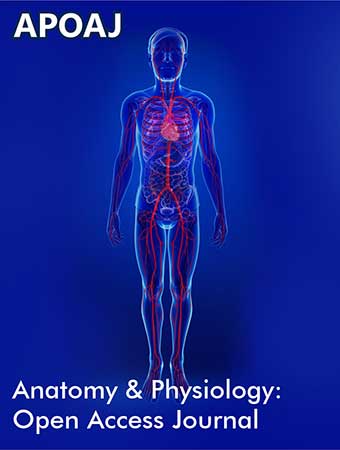 Research Article
Research Article
History of the Life and Scientific Deed of Academician Ivan Pavlov in the Reflection of Philately, Faleristics and Numismatics
Bugaevsky KA*
Department of Medical and Biological Foundations of Sports and Physical Rehabilitation, The Petro Mohyla Black Sea State University, Nikolaev, Ukraine
Konstantin Anatolyevich Bugaevsky, Assistant Professor, The Petro Mohyla Black Sea State University, Ukraine.
Received Date: May 16, 2022; Published Date: June 15, 2022
Abstract
This article is the result of a study on the memory of the world-renowned physiologist, Nobel Prize winner, Academician Ivan Petrovich Pavlov, in such collectibles as philately, numismatics and faleristics. Brand new postage stamps and envelopes, commemorative coins and medals, badges that have never been included in the author’s research materials have been presented. The illustrative part of the article is provided with textual comments to the presented materials.
Keywords:Ivan petrovich pavlov; History of physiology; Famous physiologist; Philately; Numismatics; Faleristics
Introduction
The pages of life and scientific activity of the great Russian scientist, Academician Ivan Petrovich Pavlov (1849-1936) are written in gold letters in the history of world science and, in particular, world physiology and medicine. About the lives of great people, you can learn from their memoirs, reading their biographies in reference books and encyclopedias, watching movies about them. But there is still a special world - the world of collecting, through which you can learn a lot of new, previously unknown, studying the stories presented on the stamps and envelopes in philately, on orders, medals, badges and badges in faleristics, on coins-in numismatics. Every country celebrates its heroes, honored people of science, art and many spheres of human activity by issuing commemorative issues of stamps, coins, awards in their memory. There are thematic issues in collecting, dedicated to a single event or a great man. This research work is dedicated to the great Russian scientist, the founding father of modern physiology, a glorious son of the Ryazan land, Nobel Prize laureate, Academician Ivan Petrovich Pavlov [1-8].
The pages of life and scientific activity of the great Russian scientist, Academician Ivan Petrovich Pavlov (1849-1936) are written in gold letters in the history of world science and, in particular, world physiology and medicine. About the lives of great people, you can learn from their memoirs, reading their biographies in reference books and encyclopedias, watching movies about them. But there is still a special world - the world of collecting, through which you can learn a lot of new, previously unknown, studying the stories presented on the stamps and envelopes in philately, on orders, medals, badges and badges in faleristics, on coins-in numismatics. Every country celebrates its heroes, honored people of science, art and many spheres of human activity by issuing commemorative issues of stamps, coins, awards in their memory. There are thematic issues in collecting, dedicated to a single event or a great man. This research work is dedicated to the great Russian scientist, the founding father of modern physiology, a glorious son of the Ryazan land, Nobel Prize laureate, Academician Ivan Petrovich Pavlov [1-8]. made an invaluable contribution to the development of medicine, psychology and physiology. Ivan Petrovich Pavlov died on February 27, 1936 of severe pneumonia in Leningrad [1-8].
Aim
The purpose of the article is to present the results of the conducted research concerning the reflection of the memory of the world-class physiologist, Nobel Prize winner in the field of physiology and medicine, Academician Ivan Petrovich Pavlov, in the reflection of such means of collecting as philately, numismatics and faleristics.
Materials and Methods
To achieve this goal, we used such methods and tools as the study and analysis of all available sources of information, thematically relevant to the topic of the issue under study, namely: encyclopedias, reference books, thematic catalogs and articles, Internet pages.
Result and Discussion
Turning to the materials of the study, devoted to the reflection of the life and activity of Academician Ivan Pavlov in the means of collecting, it should be noted that Ivan Pavlovich himself was a passionate collector. He collected collections of butterflies and plants, books and paintings. And, of course, he was a passionate philatelist, using every suitable opportunity to add to his stamp collection [9, 10].
The collection of stamps dedicated to the 100th anniversary of I.P. Pavlov begins with 2 postage stamps of the USSR (1949), par value 40 kopecks and 1 ruble, which is a copy of the famous painting “Portrait of Academician Pavlov” by Mikhail Vasilyevich Nesterov, painted by him in 1935, a year before his death. This portrait was the second of I.P. Pavlov’s portraits painted by M.V. Nesterov. It is now in the collection of the Tretyakov Gallery. In this picture the scientist is depicted in his house located on the territory of the biological station in Koltushi, near Leningrad, where I.P. Pavlov lived and worked at that time [9, 2]. On these stamps are the famous words of the scientist-patriot: “Whatever I do, I always think that I serve with it, first of all, my fatherland. These postage stamps of the USSR, and the cartomaxims with the scientist’s portrait [11-19], are shown in (Figure 1).
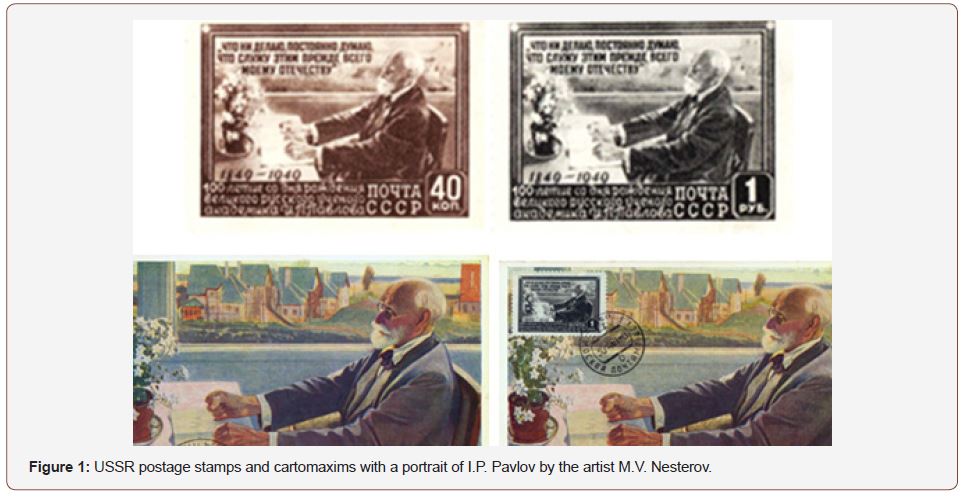
Also by the USSR Post (1961), in the year was issued a postal envelope with the portrait of the scientist, the signature “I.P. Pavlov” and the dates of his life “1849-1936”, and a postal label with his portrait is included in the series of Russian scientists in philumenia, issued in 1969 by the factory “Revput”. [11-19], (Figure 2).
In 1969, for the 120th anniversary of the scientist’s birth, the USSR post office issued a number of philatelic materials-a postage stamp of 4 kopecks and kartmaxims and an art stamped envelope with his portrait images [11-19], shown in (Figure 3).
There is also an interesting USSR philatelic material (1991) devoted to Academician I.P. Pavlov as the first Russian Nobel Prize winner [2,11-14]. As you know, on December 10, 1904 I.P. Pavlov received the Nobel Prize for his classic works on physiology in the field of digestion [1-8], an honorary member of 132 scientific societies and academies [11-19]. This postage stamp, kartmaxims, and first-day envelope (KPD), with the original special postmark [11-19], are shown in (Figure 4).
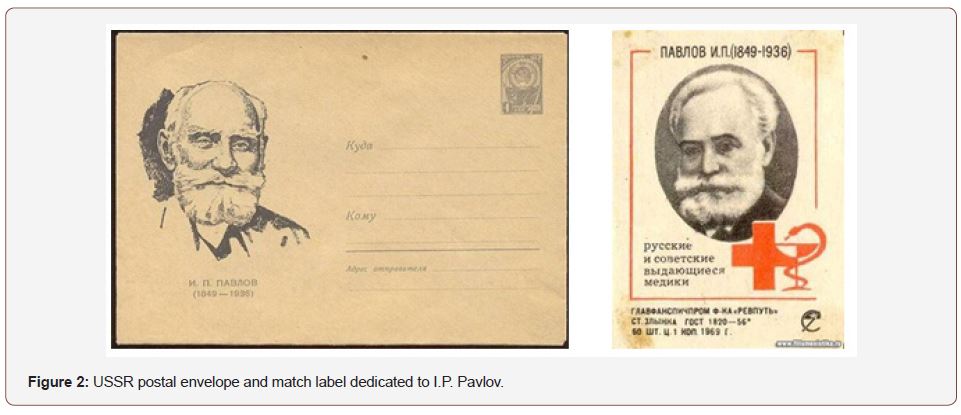
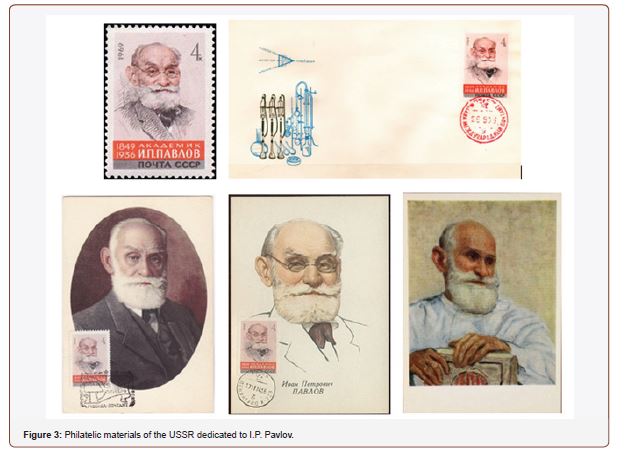
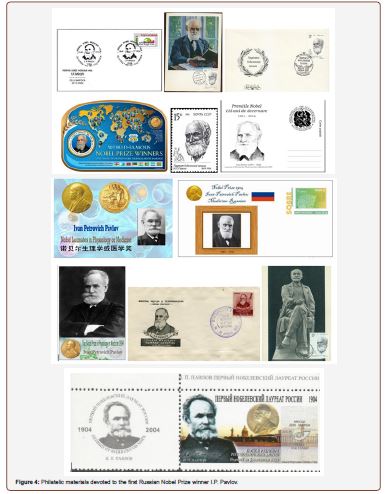
The “Nobel” merits of the great scientist were not ignored by the Russian Post (1991, 2009), which issued in honor of Academician I.P. Pavlov and to the 160th anniversary of his birth artistic marked envelopes [20], shown in (Figure 5).
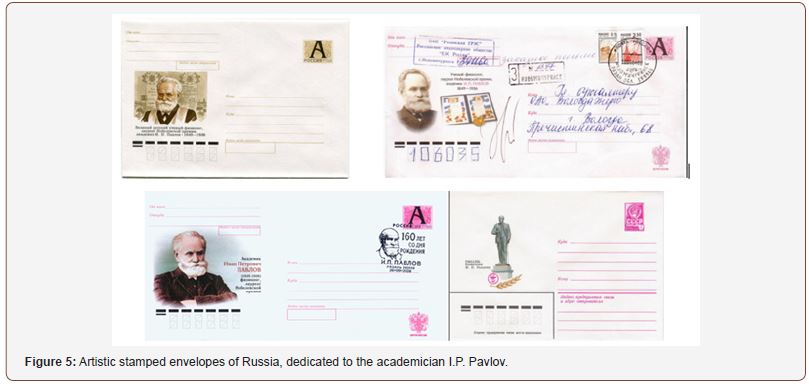
Of particular artistic and collector’s interest is an art stamped envelope of Russia and a postmark of special stamping dedicated to this event, issued by the publishing and printing center “Marka” and dedicated to the 60th anniversary of the establishment of the memorial museum-estate of Academician I.P. Pavlov in his small motherland, in Ryazan in 1946 [20], shown in (Figure 6).
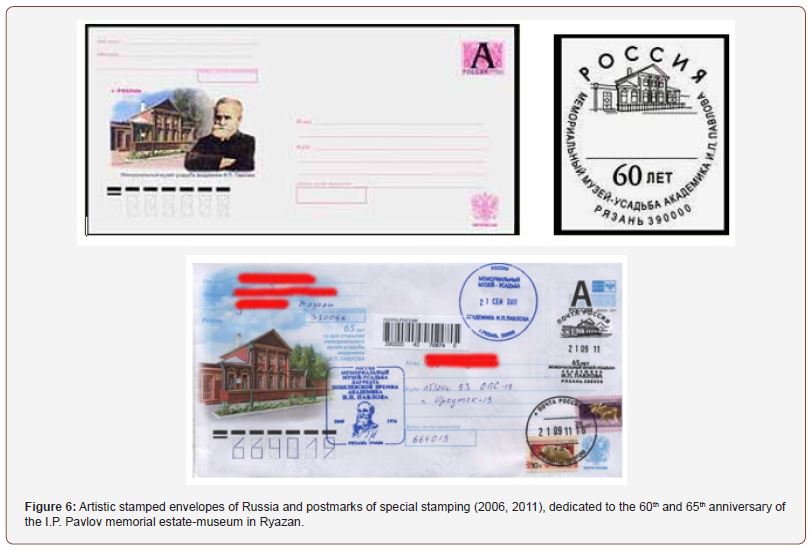
The memory of the great Russian scientist, the father of modern physiology, Academician I.P. Pavlov is also represented in foreign philately. The post offices of Hungary, Romania, Sweden, Guinea- Bissau, the Republic of Mali, Cuba, Ukraina and Argentina, in their postal series devoted to the scientists of the world, did not forget to issue a postage stamp with a portrait of the scientist. These philatelic materials dedicated to the scholar [11-19] are shown in (Figure 7).
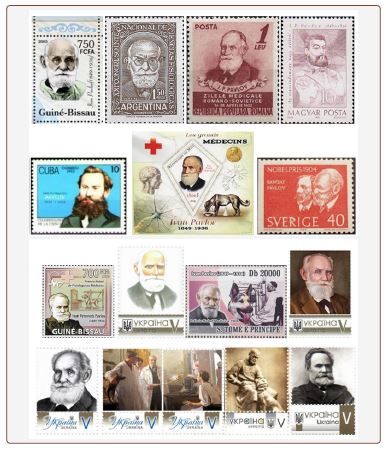
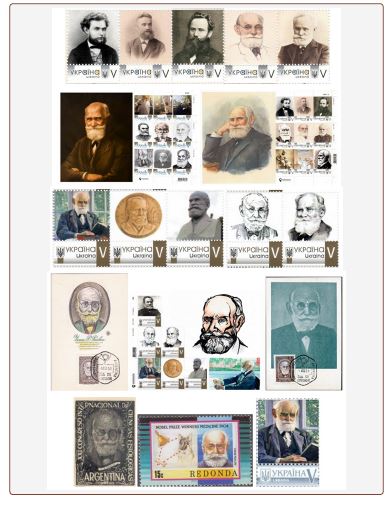
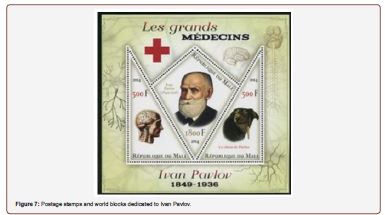
Turning to the reflection of the memory of the great physiologist in numismatics, I would like to present two commemorative coins of Russia (1999), issued by the Bank of Russia to the 150th anniversary of I.P. Pavlov and presented in (Figure 8) [21].
Phaleristics also did not ignore the contribution of Academician I.P. Pavlov to world science. A number of commemorative table medals are dedicated to him, some of which are minted according to sketches of the famous American medalist Adam Bielski. They are presented in (Figure 9) [5, 8, 22, 23].
There are also other commemorative medals (table medal “50 years of scientific activity of I.P. Pavlov”. Medalist Vasyutinsky A.F. - (Figure 10b), issued in honor of the great scientist, presented in (Figure 10a) and (Figure 10b) [8, 22].



According to Wikipedia, in the section devoted to I.P. Pavlov, there are awards named after I.P. Pavlov [4]. The first award named after the great scientist was the I.P. Pavlov Award, established by the USSR Academy of Sciences in 1934 and awarded for the best scientific work in the field of physiology. In 1949, in connection with the 100th anniversary of the scientist’s birth, the USSR Academy of Sciences established the I.P. Pavlov gold medal, which is awarded for the totality of works on the development of Ivan Petrovich Pavlov’s doctrine (Figure 11a). There is a medal of I.P. Pavlov of the Leningrad Physiological Society. In 1998 on the threshold of the 150th anniversary of I.P. Pavlov’s birth the public organization “Russian Academy of Natural Sciences” established a silver medal named after I.P. Pavlov “For development of medicine and public health” (Figure 11b). There is a memorable gold medal named after I.P. Pavlov of the Union of physiological societies of CIS countries (Figure 11c), a medal in memory of I.P. Pavlov receiving the Nobel Prize in 1904. (Figure 11d), commemorative medal on Pavlov’s readings in Ryazan in 1989 (Figure 11е-n) [3-5, 7, 8, 22, 23].
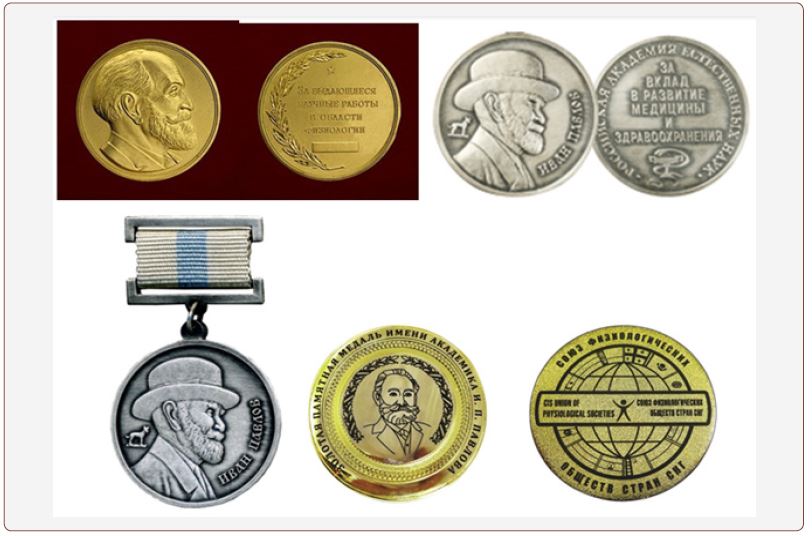
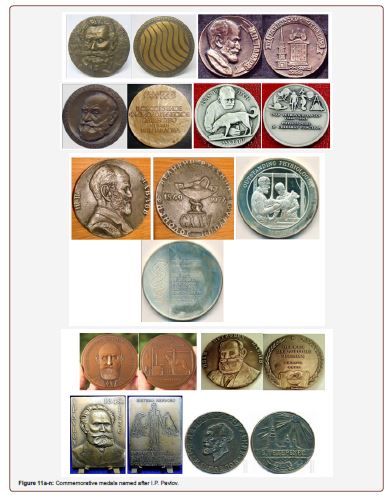
There is also a commemorative medal, dedicated to the 100th anniversary of the Institute of Experimental Medicine of the USSR Academy of Medical Sciences in Leningrad (1890-1990) with the image of the famous “Pavlov” dog on a pedestal fountain (sculptor A.F. Bespalov), shown in (Figure 12) [2].
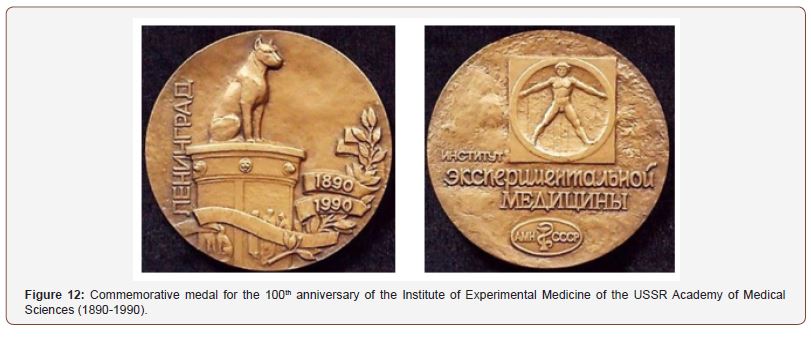
In the history of faleristics there are sketches of orders of I.P. Pavlov (author-artist A.I. Kuznetsov (1945) [2], presented in (Figure 13).
There are also other sketches of variants of the Order of I.P. Pavlov І and ІІ degree, made in 1945 by artist E.A. Levinson, also in 1945 [2], presented in (Figure 14).
Quite interesting are the sketches of I.P. Pavlov orders, made by artists I. Franz and Konstantinov (1945) [2] and presented in (Figure 15).
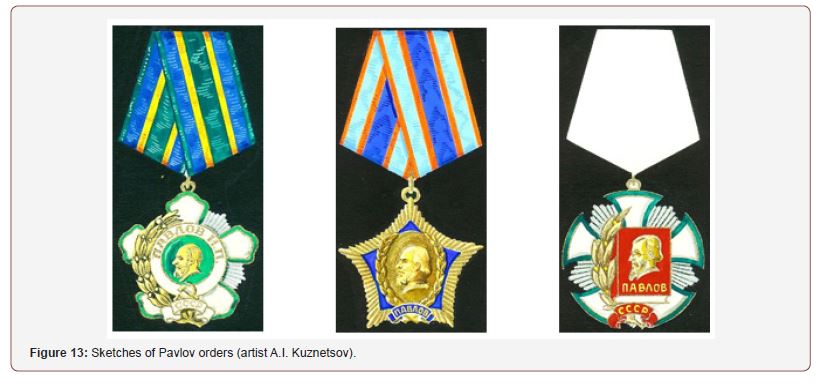
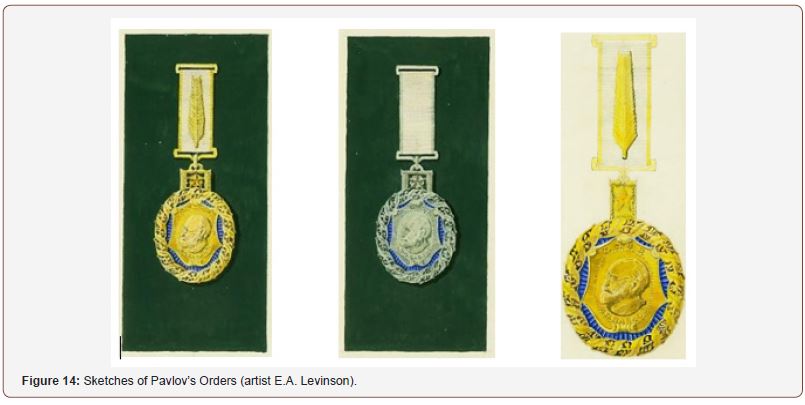

In conclusion we would like to present a part of the faleristic material devoted to the memory of I.P. Pavlov in the badges of the USSR period, concerning both the scientist personally and organizations and educational institutions, bearing his glorious name. These are badges, devoted to the 15th Congress of the All- Union Physiological Society and Leningrad Medical University named after I.P. Pavlov, presented in (Figure 16) [5, 15, 22, 24].
This concludes the story about the results of the study on the reflection of the memory of the great Russian scientist-physiologist, with world fame, Academician Ivan Petrovich Pavlov, in the reflection of various means of collecting.

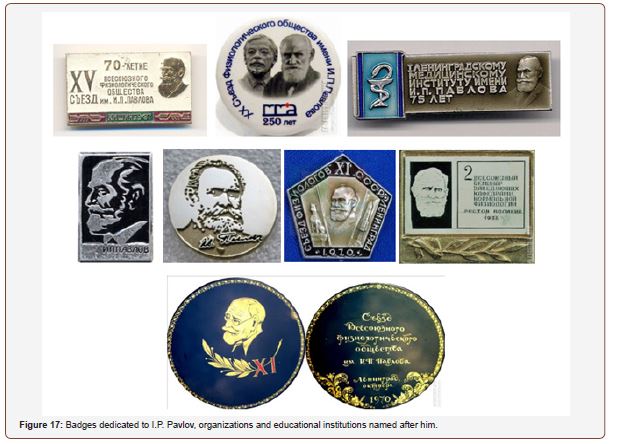
Conclusion
1. Summarizing the conducted research work devoted to the study of the memory of Academician I.P. Pavlov in philately, numismatics and faleristics, it should be noted that these means of collecting paid tribute to the scientist, dedicating to him a sufficient number of commemorative collection materials.
2. Collectibles, in all their diversity, are able to informatively present the available data on the history of medicine and, in particular, physiology.
3. Studying and preserving the history of world medicine, and such an important section of it as the history of anatomy, will allow to preserve in the memory of new generations, important historical facts, about the discoverers of this science.
Acknowledgement
None.
Conflict of Interest
No conflict of interest.
References
-
Bugaevsky KA. History of the Life and Scientific Deed of Academician Ivan Pavlov in the Reflection of Philately, Faleristics and Numismatics. Anat & Physiol Open Access J. 1(2): 2022. APOAJ.MS.ID.000510.
-
Psychology, Numismatics, Stamps, Coins, Pedagogy, Postage stamp, Philatelic materials, Ryazan, Pavlov, Faleristic material
-

This work is licensed under a Creative Commons Attribution-NonCommercial 4.0 International License.



